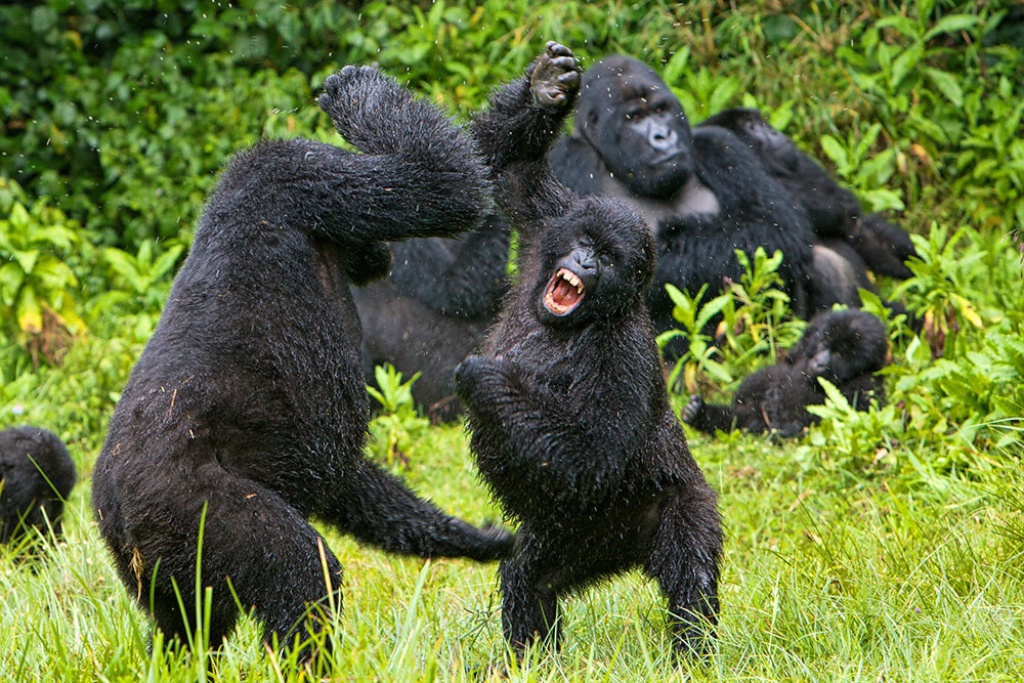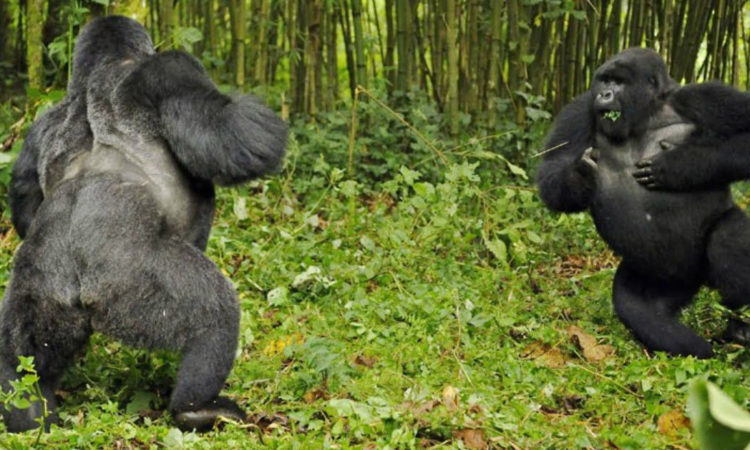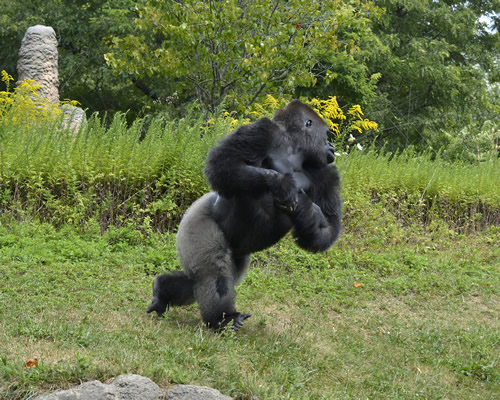Gorilla defense mechanism and their predators
Predators and gorilla protection mechanisms: protection mechanisms are inadvertent psychological responses that reduce stress in response to an unbearably unpleasant input. In order to protect themselves, mountain gorillas also have a variety of defense systems. Despite their enormous stature and stocky build, mountain gorillas are nonetheless vulnerable to predators and other outside threats. The two most frequent predators of mountain gorillas are people and leopards. While humans can kill gorillas, it is typically a challenging task because these animals live in families or groups. Due to their ability to climb trees, leopards prey on mountain gorillas and especially take advantage of this at night when the animals are less vigilant.

The greatest threat to mountain gorillas is humans, as they can become victims of gunshot wounds or be caught in traps. Because mountain gorillas are often poached for their flesh, particularly in the Democratic Republic of the Congo, they have evolved a number of protective systems.
striking their chests.
When faced with fear or extreme discomfort, mountain gorillas beat their chests and stump their feet while emitting loud sounds, similar to hooting. This is done in an attempt to frighten the predator and warn other group members or family members to flee to safety. The dominant silverback has an obligation to protect and battle for the other members of the family, sometimes even to the point of death. At times, silverbacks even damage plants in an attempt to frighten away their adversaries.
Defense systems and predators of gorillas
Striking the Chest
To look larger and taller, stand erect.
Standing tall helps mountain gorillas deter predators by giving the impression that they are larger and more formidable. This is an unusual defensive strategy.

Their powerful hands.
In general, mountain gorillas have thick bodies and powerful hands, which they employ to fend off predators, particularly leopards. Their hands also help them move more easily and support them when they lift or smash heavy objects. In a similar vein, mountain gorillas’ enormous size terrifies their adversaries. As a protection tactic, dominant silverbacks typically weigh more than females and are larger than their adversaries, which include humans and leopards.
exposing and showcasing their powerful canine teeth.
In order to frighten off their adversary, mountain gorillas also charge when they sense danger. They do this by baring and exhibiting their powerful canine teeth. Their opponent may even die at the hands of their canines, particularly if they inflict serious wounds.
establishing solid bonds with silverbacks.
Dominant silverbacks are regarded as the protectors of their particular gorilla families or groups, just like fathers are in a regular home. Silverbacks are often the target of strong bonds formed by females and young when the latter are in danger or need defense.
Never stops moving and congregating in bunches.
In order to protect themselves, mountain gorillas always live and move in groups. The proverb “divided we fall, united we stand” applies to gorilla groups. When silverbacks band together, it is simpler for them to combat their shared opponent—poachers and leopards—but an enemy can quickly kill a lone silverback.

There are currently 1063 mountain gorillas in the endangered species, and trekking takes place in three different nations. Rwanda (where they are trekked within Volcanoes National Park) and the Democratic Republic of the Congo (where they are trekked within Virunga National Park) offer two gorilla trekking destinations: Bwindi Impenetrable and Mgahinga Gorilla National Parks, home to a total of 21 habituated gorilla groups. Gorilla defense mechanisms and predators
predators of mountain gorillas.
You will be left with the impression that mountain gorillas are unthreatening due to their enormous size when you see them in the jungle. However, the reality remains that these primates are in danger in their natural environment due to predators. Of course, mountain gorillas are socially and intellectually sophisticated creatures. Even though they are a small species with a low birth rate, mountain gorillas are nonetheless in danger of going extinct. The top predators that pose a threat to them are listed below.
People.
But, due to their many activities, humans have also started to pose a hazard. The habitat of gorillas has been steadily lost due to human encroachment for a variety of reasons, such as farming, illicit hunting and poaching, and warfare.
Because they can spread infectious diseases, humans pose a hazard to mountain gorillas. Because humans and these primates share at least 98% of their genetic makeup, these animals are not safe. The habitat of mountain gorillas is also seriously threatened by climate change, which is mostly due to human activity.
Leopards.
In their natural environment, mountain gorillas are mostly preyed upon by leopards. Given their intelligence and factual diet, leopards are able to take down an adult mountain gorilla. Additionally, they are capable of climbing trees, which makes it difficult for mountain gorillas to stay safe, even when they attempt to do so.
Primarily, leopards hunt juvenile silverbacks rather than fully grown adults. However, they can track down the lowlands in the West.
The crocodile.
Among the predators of mountain gorillas are crocodiles. Even though mountain gorillas don’t often drink water, they wait for them near the banks of the stream and attack them when they try to get a drink. In swamps, crocodiles can occasionally wait for gorillas. It’s interesting that mountain gorillas can defend themselves. Mountain gorillas are able to warn others of impending danger as soon as they spot a predator. The family gathers around the dominant silverback, who serves as the family’s leader and is tasked with keeping the others safe from harm.
In order to protect themselves from their adversaries, males and females might form tight bonds. If the trespasser does not leave, the dominant silverback can challenge him. If there are black backs in the gorilla troop, they can direct the others away from predators or even launch a group attack on the adversary.
Note: All tourists who wish to trek with mountain gorillas must show a valid gorilla permit, and the cost varies. Be ready to pay approximately US $800 for a gorilla permit in Uganda, US $1500 for a permit in Rwanda, and US $450 for a permit in the Congo. Gorilla trekking licenses are required for individuals who are 15 years of age or older, and a reputable Uganda safari compant such as select adventure safaris can arrange for you .
